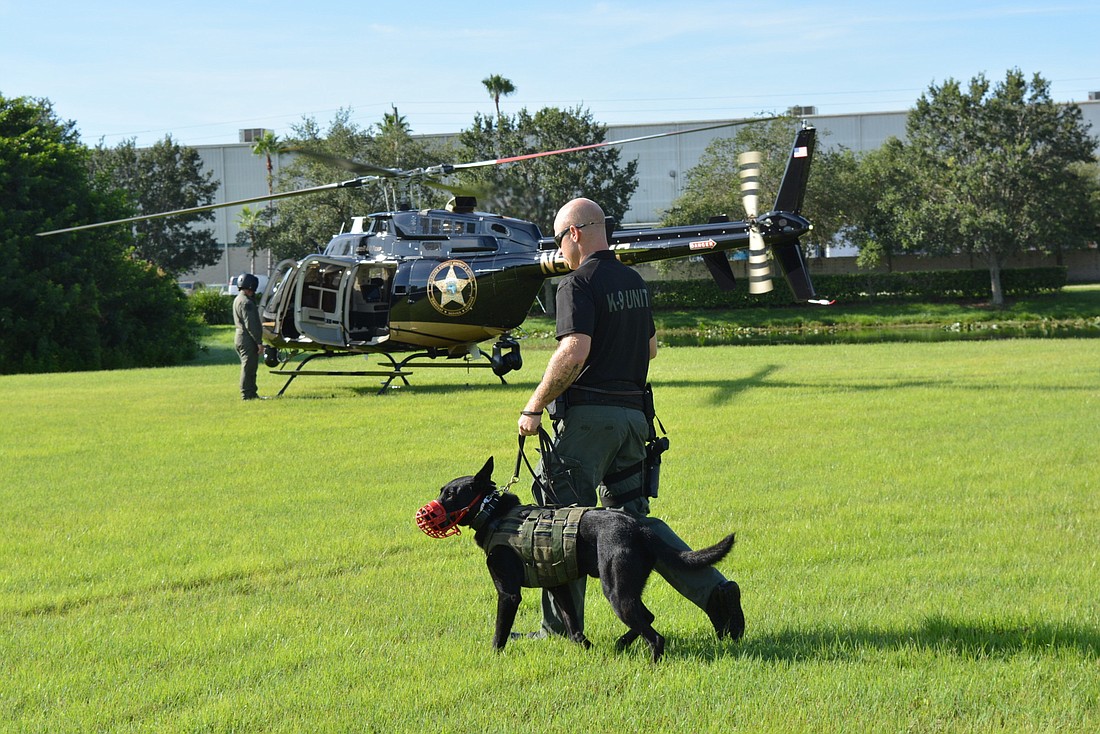- November 4, 2024
-
-
Loading

Loading

Ron seemed as eager to ride a helicopter as any kid would be.
Except, the 2-year-old is a black Malinois with the Manatee County Sheriff’s Office. He pulled his handler, deputy Jerod Wolfe, toward the helicopter, its blades still whirling, that had landed at Manatee County’s
Emergency Operations Center on Aug. 20.
The pair climbed aboard and returned about 15 minutes later, landing in a different spot. On the ground, Ron took a quick look around before getting to work by shoving his nose into the grass. He pulled Wolfe with even more enthusiasm, and in less than a minute, he had located a subject hiding in the woods nearby.
Ron and the other eight K-9 units at the Sheriff’s Office have been undergoing training meant to improve response times in the eastern portion of Manatee County. K-9 units assist with finding subjects with warrants out for their arrest and in other situations, such as burglaries in progress or at scenes of violent crimes.
Normally, K-9s ride with their handlers to the scene, which can take up to an hour by car when traveling to the county’s more rural areas. But with K-9s trained to ride in helicopters, a K-9 unit, in many cases, could respond in just 10 to 15 minutes.
“We have a very unique county,” Sgt. Steve Chenard said. “It’s very diverse. With nine dog teams, we want to make sure we’re serving East County residents just as [we are serving] residents in Bradenton.
“This is going to allow our K-9 units to have a much faster response time,” he said. “That’s the goal here.”
The change also should improve success rates for tracking subjects in rural areas.
Through footsteps, each person leaves behind a unique odor K-9s can follow. Sheriff’s Office dogs are trained to trail people by following their scents on the ground.
Chenard said the longer the odor sits, the more it dissipates, which makes it harder for dogs to follow it. The Sheriff’s Office K-9s normally track trails no more than one hour old but have been successful tracking trails up to two hours old.
Chenard said the whirling of the helicopter also spreads the odor like a smoke bomb, so it was important to see how the wind would impact each dog’s ability to track a suspect and how closely a helicopter could land to where a suspect was last seen.
K-9s began training about a month ago. First, their handlers took them to the helicopter hangar at the Sarasota-Bradenton International Airport. Chenard said the dogs got used to being around the helicopter by climbing in and out of it and sitting inside it. Later, they were introduced to the helicopter with its blades in motion, as well as to pilots and other workers in industry.
“Dogs are like people,” Chenard said. “They all have personalities. Some of them did great. Some needed more time to get used to it.”
The training exercise Aug. 20 marked the culmination of training with the K-9s riding in the helicopter then landing to track a suspect.
Chenard said the exercise was especially valuable for handlers, so they could learn how far from the helicopter the K-9s would need to be before they could hone in on a scent.
Manatee County Aviation Unit Supervisor Sgt. Joe Skala said the department’s helicopter can be airborne in less than four minutes. It uses its Bell 407GXP helicopter to track vehicles from the air at a distance — typically about 800 feet high — as well as to conduct daily routine patrols.
Skala said having dogs in the helicopters is not much different for the pilot and tactical flight officer, who operates cameras and other equipment, aboard. The K-9s wear harnesses and muzzles and are tethered in place during the flight.